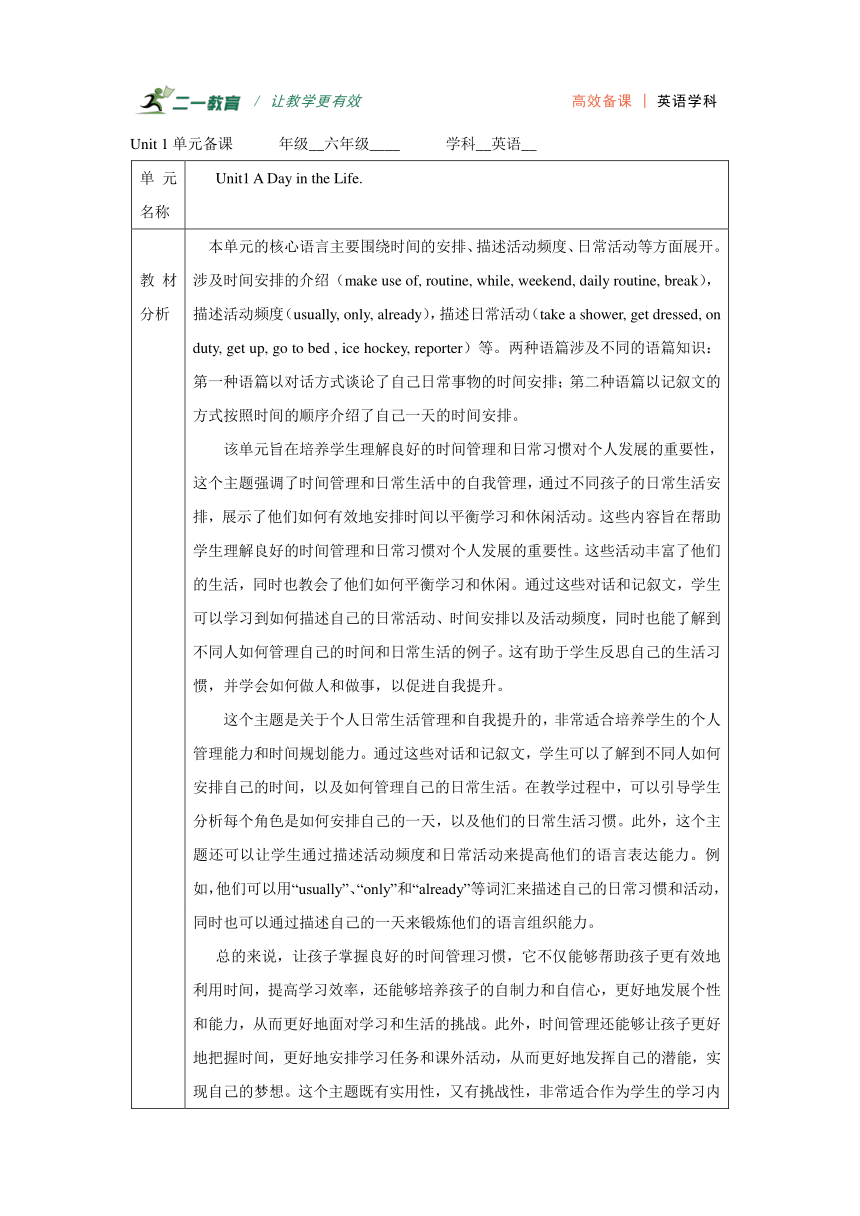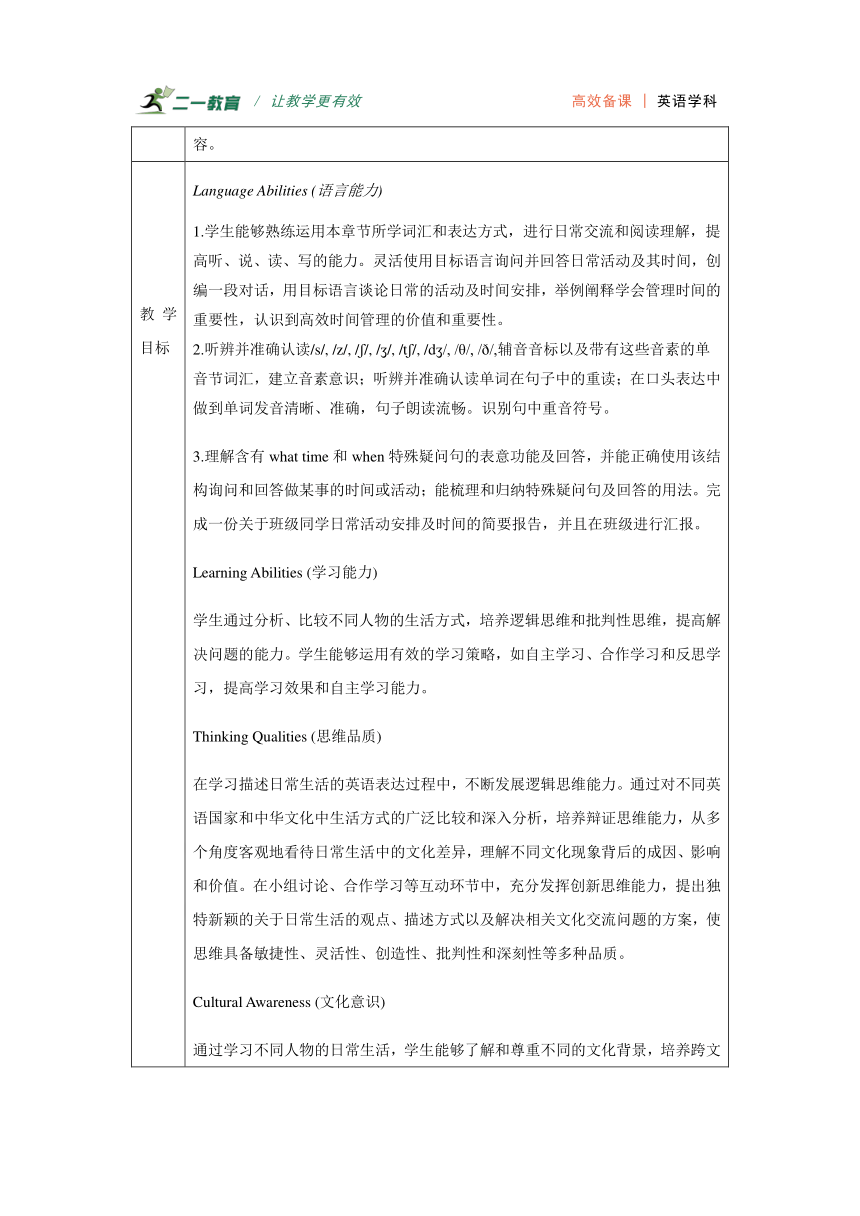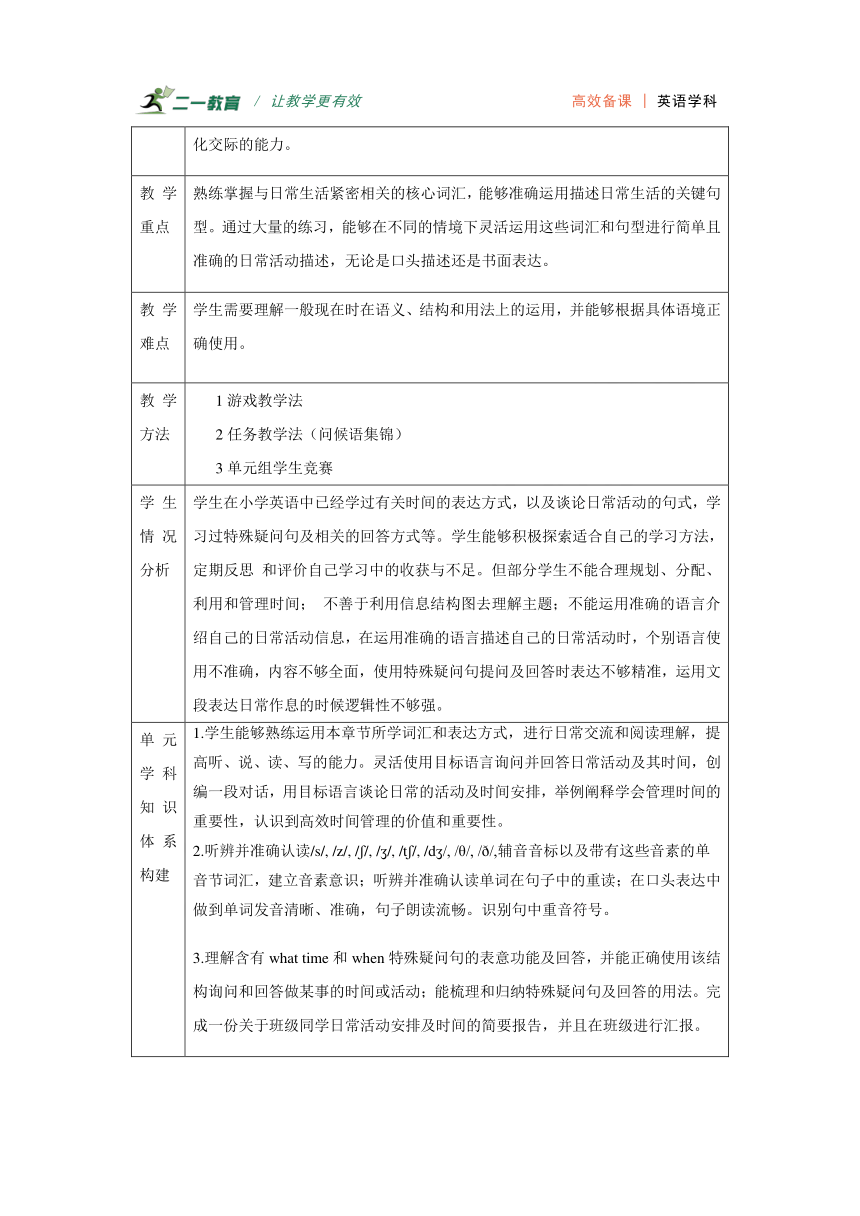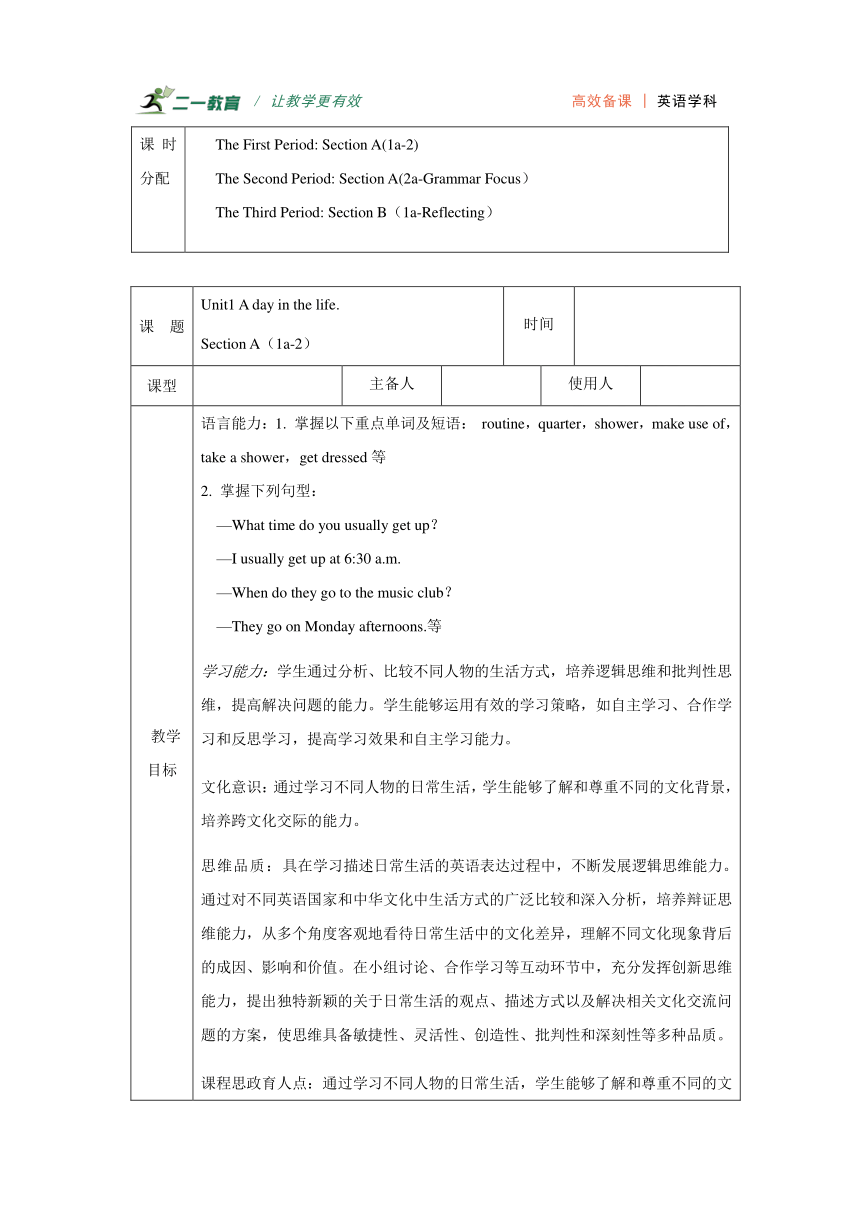Unit 1单元整体教学分析+课时教案(3课时)-2024-2025学年鲁教版(五四制)(2024)六年级下学期
文档属性
| 名称 | Unit 1单元整体教学分析+课时教案(3课时)-2024-2025学年鲁教版(五四制)(2024)六年级下学期 |  | |
| 格式 | docx | ||
| 文件大小 | 49.3KB | ||
| 资源类型 | 试卷 | ||
| 版本资源 | 鲁教版 | ||
| 科目 | 英语 | ||
| 更新时间 | 2025-02-14 14:41:11 | ||
图片预览





文档简介
/ 让教学更有效 高效备课 | 英语学科
Unit 1单元备课 年级__六年级____ 学科__英语__
单元名称 Unit1 A Day in the Life.
教材分析 本单元的核心语言主要围绕时间的安排、描述活动频度、日常活动等方面展开。涉及时间安排的介绍(make use of, routine, while, weekend, daily routine, break),描述活动频度(usually, only, already),描述日常活动(take a shower, get dressed, on duty, get up, go to bed , ice hockey, reporter)等。两种语篇涉及不同的语篇知识:第一种语篇以对话方式谈论了自己日常事物的时间安排;第二种语篇以记叙文的方式按照时间的顺序介绍了自己一天的时间安排。 该单元旨在培养学生理解良好的时间管理和日常习惯对个人发展的重要性,这个主题强调了时间管理和日常生活中的自我管理,通过不同孩子的日常生活安排,展示了他们如何有效地安排时间以平衡学习和休闲活动。这些内容旨在帮助学生理解良好的时间管理和日常习惯对个人发展的重要性。这些活动丰富了他们的生活,同时也教会了他们如何平衡学习和休闲。通过这些对话和记叙文,学生可以学习到如何描述自己的日常活动、时间安排以及活动频度,同时也能了解到不同人如何管理自己的时间和日常生活的例子。这有助于学生反思自己的生活习惯,并学会如何做人和做事,以促进自我提升。 这个主题是关于个人日常生活管理和自我提升的,非常适合培养学生的个人管理能力和时间规划能力。通过这些对话和记叙文,学生可以了解到不同人如何安排自己的时间,以及如何管理自己的日常生活。在教学过程中,可以引导学生分析每个角色是如何安排自己的一天,以及他们的日常生活习惯。此外,这个主题还可以让学生通过描述活动频度和日常活动来提高他们的语言表达能力。例如,他们可以用“usually”、“only”和“already”等词汇来描述自己的日常习惯和活动,同时也可以通过描述自己的一天来锻炼他们的语言组织能力。 总的来说,让孩子掌握良好的时间管理习惯,它不仅能够帮助孩子更有效地利用时间,提高学习效率,还能够培养孩子的自制力和自信心,更好地发展个性和能力,从而更好地面对学习和生活的挑战。此外,时间管理还能够让孩子更好地把握时间,更好地安排学习任务和课外活动,从而更好地发挥自己的潜能,实现自己的梦想。这个主题既有实用性,又有挑战性,非常适合作为学生的学习内容。
教学目标 Language Abilities (语言能力) 1.学生能够熟练运用本章节所学词汇和表达方式,进行日常交流和阅读理解,提高听、说、读、写的能力。灵活使用目标语言询问并回答日常活动及其时间,创编一段对话,用目标语言谈论日常的活动及时间安排,举例阐释学会管理时间的重要性,认识到高效时间管理的价值和重要性。 2.听辨并准确认读/s/, /z/, / /, / /, /t /, /d /, /θ/, / /,辅音音标以及带有这些音素的单音节词汇,建立音素意识;听辨并准确认读单词在句子中的重读;在口头表达中做到单词发音清晰、准确,句子朗读流畅。识别句中重音符号。 3.理解含有what time和when特殊疑问句的表意功能及回答,并能正确使用该结构询问和回答做某事的时间或活动;能梳理和归纳特殊疑问句及回答的用法。完成一份关于班级同学日常活动安排及时间的简要报告,并且在班级进行汇报。 Learning Abilities (学习能力) 学生通过分析、比较不同人物的生活方式,培养逻辑思维和批判性思维,提高解决问题的能力。学生能够运用有效的学习策略,如自主学习、合作学习和反思学习,提高学习效果和自主学习能力。 Thinking Qualities (思维品质) 在学习描述日常生活的英语表达过程中,不断发展逻辑思维能力。通过对不同英语国家和中华文化中生活方式的广泛比较和深入分析,培养辩证思维能力,从多个角度客观地看待日常生活中的文化差异,理解不同文化现象背后的成因、影响和价值。在小组讨论、合作学习等互动环节中,充分发挥创新思维能力,提出独特新颖的关于日常生活的观点、描述方式以及解决相关文化交流问题的方案,使思维具备敏捷性、灵活性、创造性、批判性和深刻性等多种品质。 Cultural Awareness (文化意识) 通过学习不同人物的日常生活,学生能够了解和尊重不同的文化背景,培养跨文化交际的能力。
教学 重点 熟练掌握与日常生活紧密相关的核心词汇,能够准确运用描述日常生活的关键句型。通过大量的练习,能够在不同的情境下灵活运用这些词汇和句型进行简单且准确的日常活动描述,无论是口头描述还是书面表达。
教学难点 学生需要理解一般现在时在语义、结构和用法上的运用,并能够根据具体语境正确使用。
教学方法 1游戏教学法 2任务教学法(问候语集锦) 3单元组学生竞赛
学生情况分析 学生在小学英语中已经学过有关时间的表达方式,以及谈论日常活动的句式,学习过特殊疑问句及相关的回答方式等。学生能够积极探索适合自己的学习方法,定期反思 和评价自己学习中的收获与不足。但部分学生不能合理规划、分配、利用和管理时间; 不善于利用信息结构图去理解主题;不能运用准确的语言介绍自己的日常活动信息,在运用准确的语言描述自己的日常活动时,个别语言使用不准确,内容不够全面,使用特殊疑问句提问及回答时表达不够精准,运用文段表达日常作息的时候逻辑性不够强。
单元学科知识体系构建 1.学生能够熟练运用本章节所学词汇和表达方式,进行日常交流和阅读理解,提高听、说、读、写的能力。灵活使用目标语言询问并回答日常活动及其时间,创编一段对话,用目标语言谈论日常的活动及时间安排,举例阐释学会管理时间的重要性,认识到高效时间管理的价值和重要性。 2.听辨并准确认读/s/, /z/, / /, / /, /t /, /d /, /θ/, / /,辅音音标以及带有这些音素的单音节词汇,建立音素意识;听辨并准确认读单词在句子中的重读;在口头表达中做到单词发音清晰、准确,句子朗读流畅。识别句中重音符号。 3.理解含有what time和when特殊疑问句的表意功能及回答,并能正确使用该结构询问和回答做某事的时间或活动;能梳理和归纳特殊疑问句及回答的用法。完成一份关于班级同学日常活动安排及时间的简要报告,并且在班级进行汇报。
课时分配 The First Period: Section A(1a-2) The Second Period: Section A(2a-Grammar Focus) The Third Period: Section B(1a-Reflecting)
课 题 Unit1 A day in the life. Section A(1a-2) 时间
课型 主备人 使用人
教学目标 语言能力:1. 掌握以下重点单词及短语: routine,quarter,shower,make use of,take a shower,get dressed等 2. 掌握下列句型: —What time do you usually get up? —I usually get up at 6:30 a.m. —When do they go to the music club? —They go on Monday afternoons.等 学习能力:学生通过分析、比较不同人物的生活方式,培养逻辑思维和批判性思维,提高解决问题的能力。学生能够运用有效的学习策略,如自主学习、合作学习和反思学习,提高学习效果和自主学习能力。 文化意识:通过学习不同人物的日常生活,学生能够了解和尊重不同的文化背景,培养跨文化交际的能力。 思维品质:具在学习描述日常生活的英语表达过程中,不断发展逻辑思维能力。通过对不同英语国家和中华文化中生活方式的广泛比较和深入分析,培养辩证思维能力,从多个角度客观地看待日常生活中的文化差异,理解不同文化现象背后的成因、影响和价值。在小组讨论、合作学习等互动环节中,充分发挥创新思维能力,提出独特新颖的关于日常生活的观点、描述方式以及解决相关文化交流问题的方案,使思维具备敏捷性、灵活性、创造性、批判性和深刻性等多种品质。 课程思政育人点:通过学习不同人物的日常生活,学生能够了解和尊重不同的文化背景,培养跨文化交际的能力。
教学重点 学生能够熟练运用本章节所学词汇和表达方式,进行日常交流和阅读理解,提高听、说、读、写的能力。
教学难点 一般现在时的使用。
教具准备 PPT 教案 教材 练习册
Step 1 Warming up and revision T:Today we are going to learn Unit 6. First let’s look at the title and the picture. What are we going to learn this unit Yes, we are going to learn something about a day in the life. Look at the picture and share the three questions. What do you see in the photo How long do you study every day What do you do in your free time Step 2 Presentation Work on 1a Let’s look at the pictures. Here are four clocks and what time they are. Do you know how to tell the time. Please match the clocks with the times. Listen to the first conversation and tick Peter’s activities this morning. Let’s check the answers together. Yes, we got the answer that is brushing his teeth, get dressed. Listen to the first conversation and tick Peter’s activities this morning. Let’s check the answers together. Yes, we got the answer that is brushing his teeth, get dressed. Step 3 Listening Work on 1b Listen to the first conversation and tick Peter’s activities this morning. Let’s check the answers together. Yes, we got the answer that is brushing his teeth, get dressed. Step4 Listening Work on 1c Listen to the second conversation. Why are Peter and Han Lin at school early Match the names with the reasons. Let’s check the answer together. Yes, Peter is on duty and Han Lin does some reading before class. Listen to the two conversations again and fill in the blanks. ①Peter’s school begins at__________ ②Peter usually gets up at __________. ③Peter usually has breakfast at __________ ④Peter usually takes a shower __________ ⑤Han Lin usually takes a shower __________. Step 5 Role play Work on 1e 1.Let’s try to role-play the conversation and show yourselves in front of the class. Try to use your own words. Practice the conversations with your partner. Then make your own conversations. What time do you usually get up I usually get up at 7 o’clock. When do you take a shower I usually take a shower at night. 2.Work in groups and interview three classmates and complete the chart, then tell your group about the results. Interviewer: What time do you usually.... NameActivityTimeGet upAt 7:00
Step 6 Pronunciation Work on 1 Listen and circle the sentences you hear, then repeat them.I will show you some other words. Work on 2 Look at the words. Listen and repeat. Listen to the beginning part of the conversation in 2a and repeat. Notice the stressed words. Then mark other stressed words in the conversation in 2a. Step 7 Homework(反馈与强化) Recite the language points and finish the exercise book. 二次备课
板书设计
教学反思
课 题 Unit1 A day in the life. Section A(2a-Grammar Focus) 时间
课型 主备人 使用人
教学目标 语言能力:能够通过听读对话获取汤姆上学一天的作息时间等信息;能够识别对话中询问并回答作息时间的句式,运用相关语言进行角色扮演。 学习能力:能运用目标语言,询问同班同学的学校日作息时间及活动,并在班级中完成角色扮演,认识时间管理、生活习惯和学习习惯的重要性。 文化意识:通过学习不同人物的日常生活,学生能够了解和尊重不同的文化背景,培养跨文化交际的能力。 思维品质:具在学习描述日常生活的英语表达过程中,不断发展逻辑思维能力。在小组讨论、合作学习等互动环节中,充分发挥创新思维能力,提出独特新颖的关于日常生活的观点、描述方式以及解决相关文化交流问题的方案,使思维具备敏捷性、灵活性、创造性、批判性和深刻性等多种品质。 课程思政育人点:能运用目标语言,认识时间管理、生活习惯和学习习惯的重要性。
教学重点 能够通过听读对话获取汤姆上学一天的作息时间等信息;能够识别对话中询问并回答作息时间的句式,运用相关语言进行角色扮演。
教学难点 能运用目标语言,认识时间管理、生活习惯和学习习惯的重要性。
教具准备 PPT 教案 教材 练习册
教学过程: Step 1 Lead- in 1.Greet the class. 2.Review the previous class by talking with students in English. 3.Give a brief introduction of the class content. Step 2 Work on 2a Let’s look at the picture. Look at the picture and answer the three questions.What is the photo about What can you see in the picture Where are they 2.Listen to the conversation and fill in the blanks. Step 3 Work on 2b Read the conversation and answer the questions. ①What does Jiaqi ask Tom about ②How long does Tom stay at school ③Why does Tom go to bed early Step 4 Work on 2c Listen again and try to complete Tom’s school day routine. Step 5 Work on 2d Listen to the conversation again and pay attention to the stressed words. Let’s try to role-play the conversation and show yourselves in front of the class. Step 6 Work on 2e Ask a partner about his or her school day routine. Step7. Grammar I. 1.Let’s read the sentences and find out the rules of sentence patterns. Read the sentences and look at the question phrase. Do you know the differences among what, what time and when. Complete the questions with what, what time or when. Step 8. Practice3b Answer the questions with the time in brackets in 3b. After that, let’s check the answers together. Step 9. Practice 3c Let’s read the plete the passage with the correct forms of the verbs in brackets in 3c. After that, we will share the answers together. Provide the chart of abbreviations for Ss to read aloud. Emphasize the pronunciation problem. Step10. Group Work Work in groups and do a survey in class.Ask a partner about his or her weekend routine. Step 11. Summary Let the students summarize the key knowledge in the lesson by themselves. Step 12. Homework Finish the exercise book.Introduce your classmates’ weekend routines.
板书设计
教学反思
课 题 Unit1 A day in the life. Section B 时间
课型 主备人 使用人
教学目标 语言能力:获取短文中有关蒂莫日程时间表的基本信息,梳理、概括蒂莫日程活动、时间等内容,借助可视化图形呈现结构化知识。 学习能力:能运用目标语言,询问同班同学的学校日作息时间及活动,并在班级中完成角色扮演,认识时间管理、生活习惯和学习习惯的重要性。 文化意识:了解不同文化背景下学生的日常生活和学习方式,拓宽学生的视野和认知。 思维品质:具在学习描述日常生活的英语表达过程中,不断发展逻辑思维能力。 课程思政育人点:通过对主人公蒂莫的品质和价值观的探究,可以引导学生树立正确的价值观和人生观,培养积极向上的人生态度。
教学重点 学会从文本中提取信息,并熟练的运用与日常生活习惯相关的词汇及表达法。
教学难点 通过阅读本篇记叙文,学生可以锻炼阅读理解能力,提高对文章主旨、细节、推理等方面的理解能力。
教具准备 PPT 教案 教材 练习册
教学过程: Step 1 Lead- in Greeting: Greet students 2.Lead- in:Do you know someone who has different daily routines from you How different are people’s daily routines Step 2 Work on la Work in groups and look at the photos below. Guess which part of the world the boy is from. What do you want to know about him Step 3 Work on 1b Read the passage and choose a suitable title for it.Let’s check the answers together. Step 4Work on 1c & 1d 1.Read again and complete the timetable with Timo’s activities. 2.Read again and answer the questions. Step 5 Work on 2a 1.Complete the timetable about one of your school days in 2a. Step 6 Work on 2b Use the information in 2a to write about your day. Step 7 Work on 1 Choose a profession that you want to know more about. Step 8 Work on 2 1Ask a person who works in that profession questions to find out his or her workday plete the time table below. Step 9 Work on 3 Give a report in class. Step 10 Reflecting Let students reflect how well they learned according to the reflecting chart. Step 11 Homework Write a passage about your daily routine.
板书设计
教学反思
Unit 1单元备课 年级__六年级____ 学科__英语__
单元名称 Unit1 A Day in the Life.
教材分析 本单元的核心语言主要围绕时间的安排、描述活动频度、日常活动等方面展开。涉及时间安排的介绍(make use of, routine, while, weekend, daily routine, break),描述活动频度(usually, only, already),描述日常活动(take a shower, get dressed, on duty, get up, go to bed , ice hockey, reporter)等。两种语篇涉及不同的语篇知识:第一种语篇以对话方式谈论了自己日常事物的时间安排;第二种语篇以记叙文的方式按照时间的顺序介绍了自己一天的时间安排。 该单元旨在培养学生理解良好的时间管理和日常习惯对个人发展的重要性,这个主题强调了时间管理和日常生活中的自我管理,通过不同孩子的日常生活安排,展示了他们如何有效地安排时间以平衡学习和休闲活动。这些内容旨在帮助学生理解良好的时间管理和日常习惯对个人发展的重要性。这些活动丰富了他们的生活,同时也教会了他们如何平衡学习和休闲。通过这些对话和记叙文,学生可以学习到如何描述自己的日常活动、时间安排以及活动频度,同时也能了解到不同人如何管理自己的时间和日常生活的例子。这有助于学生反思自己的生活习惯,并学会如何做人和做事,以促进自我提升。 这个主题是关于个人日常生活管理和自我提升的,非常适合培养学生的个人管理能力和时间规划能力。通过这些对话和记叙文,学生可以了解到不同人如何安排自己的时间,以及如何管理自己的日常生活。在教学过程中,可以引导学生分析每个角色是如何安排自己的一天,以及他们的日常生活习惯。此外,这个主题还可以让学生通过描述活动频度和日常活动来提高他们的语言表达能力。例如,他们可以用“usually”、“only”和“already”等词汇来描述自己的日常习惯和活动,同时也可以通过描述自己的一天来锻炼他们的语言组织能力。 总的来说,让孩子掌握良好的时间管理习惯,它不仅能够帮助孩子更有效地利用时间,提高学习效率,还能够培养孩子的自制力和自信心,更好地发展个性和能力,从而更好地面对学习和生活的挑战。此外,时间管理还能够让孩子更好地把握时间,更好地安排学习任务和课外活动,从而更好地发挥自己的潜能,实现自己的梦想。这个主题既有实用性,又有挑战性,非常适合作为学生的学习内容。
教学目标 Language Abilities (语言能力) 1.学生能够熟练运用本章节所学词汇和表达方式,进行日常交流和阅读理解,提高听、说、读、写的能力。灵活使用目标语言询问并回答日常活动及其时间,创编一段对话,用目标语言谈论日常的活动及时间安排,举例阐释学会管理时间的重要性,认识到高效时间管理的价值和重要性。 2.听辨并准确认读/s/, /z/, / /, / /, /t /, /d /, /θ/, / /,辅音音标以及带有这些音素的单音节词汇,建立音素意识;听辨并准确认读单词在句子中的重读;在口头表达中做到单词发音清晰、准确,句子朗读流畅。识别句中重音符号。 3.理解含有what time和when特殊疑问句的表意功能及回答,并能正确使用该结构询问和回答做某事的时间或活动;能梳理和归纳特殊疑问句及回答的用法。完成一份关于班级同学日常活动安排及时间的简要报告,并且在班级进行汇报。 Learning Abilities (学习能力) 学生通过分析、比较不同人物的生活方式,培养逻辑思维和批判性思维,提高解决问题的能力。学生能够运用有效的学习策略,如自主学习、合作学习和反思学习,提高学习效果和自主学习能力。 Thinking Qualities (思维品质) 在学习描述日常生活的英语表达过程中,不断发展逻辑思维能力。通过对不同英语国家和中华文化中生活方式的广泛比较和深入分析,培养辩证思维能力,从多个角度客观地看待日常生活中的文化差异,理解不同文化现象背后的成因、影响和价值。在小组讨论、合作学习等互动环节中,充分发挥创新思维能力,提出独特新颖的关于日常生活的观点、描述方式以及解决相关文化交流问题的方案,使思维具备敏捷性、灵活性、创造性、批判性和深刻性等多种品质。 Cultural Awareness (文化意识) 通过学习不同人物的日常生活,学生能够了解和尊重不同的文化背景,培养跨文化交际的能力。
教学 重点 熟练掌握与日常生活紧密相关的核心词汇,能够准确运用描述日常生活的关键句型。通过大量的练习,能够在不同的情境下灵活运用这些词汇和句型进行简单且准确的日常活动描述,无论是口头描述还是书面表达。
教学难点 学生需要理解一般现在时在语义、结构和用法上的运用,并能够根据具体语境正确使用。
教学方法 1游戏教学法 2任务教学法(问候语集锦) 3单元组学生竞赛
学生情况分析 学生在小学英语中已经学过有关时间的表达方式,以及谈论日常活动的句式,学习过特殊疑问句及相关的回答方式等。学生能够积极探索适合自己的学习方法,定期反思 和评价自己学习中的收获与不足。但部分学生不能合理规划、分配、利用和管理时间; 不善于利用信息结构图去理解主题;不能运用准确的语言介绍自己的日常活动信息,在运用准确的语言描述自己的日常活动时,个别语言使用不准确,内容不够全面,使用特殊疑问句提问及回答时表达不够精准,运用文段表达日常作息的时候逻辑性不够强。
单元学科知识体系构建 1.学生能够熟练运用本章节所学词汇和表达方式,进行日常交流和阅读理解,提高听、说、读、写的能力。灵活使用目标语言询问并回答日常活动及其时间,创编一段对话,用目标语言谈论日常的活动及时间安排,举例阐释学会管理时间的重要性,认识到高效时间管理的价值和重要性。 2.听辨并准确认读/s/, /z/, / /, / /, /t /, /d /, /θ/, / /,辅音音标以及带有这些音素的单音节词汇,建立音素意识;听辨并准确认读单词在句子中的重读;在口头表达中做到单词发音清晰、准确,句子朗读流畅。识别句中重音符号。 3.理解含有what time和when特殊疑问句的表意功能及回答,并能正确使用该结构询问和回答做某事的时间或活动;能梳理和归纳特殊疑问句及回答的用法。完成一份关于班级同学日常活动安排及时间的简要报告,并且在班级进行汇报。
课时分配 The First Period: Section A(1a-2) The Second Period: Section A(2a-Grammar Focus) The Third Period: Section B(1a-Reflecting)
课 题 Unit1 A day in the life. Section A(1a-2) 时间
课型 主备人 使用人
教学目标 语言能力:1. 掌握以下重点单词及短语: routine,quarter,shower,make use of,take a shower,get dressed等 2. 掌握下列句型: —What time do you usually get up? —I usually get up at 6:30 a.m. —When do they go to the music club? —They go on Monday afternoons.等 学习能力:学生通过分析、比较不同人物的生活方式,培养逻辑思维和批判性思维,提高解决问题的能力。学生能够运用有效的学习策略,如自主学习、合作学习和反思学习,提高学习效果和自主学习能力。 文化意识:通过学习不同人物的日常生活,学生能够了解和尊重不同的文化背景,培养跨文化交际的能力。 思维品质:具在学习描述日常生活的英语表达过程中,不断发展逻辑思维能力。通过对不同英语国家和中华文化中生活方式的广泛比较和深入分析,培养辩证思维能力,从多个角度客观地看待日常生活中的文化差异,理解不同文化现象背后的成因、影响和价值。在小组讨论、合作学习等互动环节中,充分发挥创新思维能力,提出独特新颖的关于日常生活的观点、描述方式以及解决相关文化交流问题的方案,使思维具备敏捷性、灵活性、创造性、批判性和深刻性等多种品质。 课程思政育人点:通过学习不同人物的日常生活,学生能够了解和尊重不同的文化背景,培养跨文化交际的能力。
教学重点 学生能够熟练运用本章节所学词汇和表达方式,进行日常交流和阅读理解,提高听、说、读、写的能力。
教学难点 一般现在时的使用。
教具准备 PPT 教案 教材 练习册
Step 1 Warming up and revision T:Today we are going to learn Unit 6. First let’s look at the title and the picture. What are we going to learn this unit Yes, we are going to learn something about a day in the life. Look at the picture and share the three questions. What do you see in the photo How long do you study every day What do you do in your free time Step 2 Presentation Work on 1a Let’s look at the pictures. Here are four clocks and what time they are. Do you know how to tell the time. Please match the clocks with the times. Listen to the first conversation and tick Peter’s activities this morning. Let’s check the answers together. Yes, we got the answer that is brushing his teeth, get dressed. Listen to the first conversation and tick Peter’s activities this morning. Let’s check the answers together. Yes, we got the answer that is brushing his teeth, get dressed. Step 3 Listening Work on 1b Listen to the first conversation and tick Peter’s activities this morning. Let’s check the answers together. Yes, we got the answer that is brushing his teeth, get dressed. Step4 Listening Work on 1c Listen to the second conversation. Why are Peter and Han Lin at school early Match the names with the reasons. Let’s check the answer together. Yes, Peter is on duty and Han Lin does some reading before class. Listen to the two conversations again and fill in the blanks. ①Peter’s school begins at__________ ②Peter usually gets up at __________. ③Peter usually has breakfast at __________ ④Peter usually takes a shower __________ ⑤Han Lin usually takes a shower __________. Step 5 Role play Work on 1e 1.Let’s try to role-play the conversation and show yourselves in front of the class. Try to use your own words. Practice the conversations with your partner. Then make your own conversations. What time do you usually get up I usually get up at 7 o’clock. When do you take a shower I usually take a shower at night. 2.Work in groups and interview three classmates and complete the chart, then tell your group about the results. Interviewer: What time do you usually.... NameActivityTimeGet upAt 7:00
Step 6 Pronunciation Work on 1 Listen and circle the sentences you hear, then repeat them.I will show you some other words. Work on 2 Look at the words. Listen and repeat. Listen to the beginning part of the conversation in 2a and repeat. Notice the stressed words. Then mark other stressed words in the conversation in 2a. Step 7 Homework(反馈与强化) Recite the language points and finish the exercise book. 二次备课
板书设计
教学反思
课 题 Unit1 A day in the life. Section A(2a-Grammar Focus) 时间
课型 主备人 使用人
教学目标 语言能力:能够通过听读对话获取汤姆上学一天的作息时间等信息;能够识别对话中询问并回答作息时间的句式,运用相关语言进行角色扮演。 学习能力:能运用目标语言,询问同班同学的学校日作息时间及活动,并在班级中完成角色扮演,认识时间管理、生活习惯和学习习惯的重要性。 文化意识:通过学习不同人物的日常生活,学生能够了解和尊重不同的文化背景,培养跨文化交际的能力。 思维品质:具在学习描述日常生活的英语表达过程中,不断发展逻辑思维能力。在小组讨论、合作学习等互动环节中,充分发挥创新思维能力,提出独特新颖的关于日常生活的观点、描述方式以及解决相关文化交流问题的方案,使思维具备敏捷性、灵活性、创造性、批判性和深刻性等多种品质。 课程思政育人点:能运用目标语言,认识时间管理、生活习惯和学习习惯的重要性。
教学重点 能够通过听读对话获取汤姆上学一天的作息时间等信息;能够识别对话中询问并回答作息时间的句式,运用相关语言进行角色扮演。
教学难点 能运用目标语言,认识时间管理、生活习惯和学习习惯的重要性。
教具准备 PPT 教案 教材 练习册
教学过程: Step 1 Lead- in 1.Greet the class. 2.Review the previous class by talking with students in English. 3.Give a brief introduction of the class content. Step 2 Work on 2a Let’s look at the picture. Look at the picture and answer the three questions.What is the photo about What can you see in the picture Where are they 2.Listen to the conversation and fill in the blanks. Step 3 Work on 2b Read the conversation and answer the questions. ①What does Jiaqi ask Tom about ②How long does Tom stay at school ③Why does Tom go to bed early Step 4 Work on 2c Listen again and try to complete Tom’s school day routine. Step 5 Work on 2d Listen to the conversation again and pay attention to the stressed words. Let’s try to role-play the conversation and show yourselves in front of the class. Step 6 Work on 2e Ask a partner about his or her school day routine. Step7. Grammar I. 1.Let’s read the sentences and find out the rules of sentence patterns. Read the sentences and look at the question phrase. Do you know the differences among what, what time and when. Complete the questions with what, what time or when. Step 8. Practice3b Answer the questions with the time in brackets in 3b. After that, let’s check the answers together. Step 9. Practice 3c Let’s read the plete the passage with the correct forms of the verbs in brackets in 3c. After that, we will share the answers together. Provide the chart of abbreviations for Ss to read aloud. Emphasize the pronunciation problem. Step10. Group Work Work in groups and do a survey in class.Ask a partner about his or her weekend routine. Step 11. Summary Let the students summarize the key knowledge in the lesson by themselves. Step 12. Homework Finish the exercise book.Introduce your classmates’ weekend routines.
板书设计
教学反思
课 题 Unit1 A day in the life. Section B 时间
课型 主备人 使用人
教学目标 语言能力:获取短文中有关蒂莫日程时间表的基本信息,梳理、概括蒂莫日程活动、时间等内容,借助可视化图形呈现结构化知识。 学习能力:能运用目标语言,询问同班同学的学校日作息时间及活动,并在班级中完成角色扮演,认识时间管理、生活习惯和学习习惯的重要性。 文化意识:了解不同文化背景下学生的日常生活和学习方式,拓宽学生的视野和认知。 思维品质:具在学习描述日常生活的英语表达过程中,不断发展逻辑思维能力。 课程思政育人点:通过对主人公蒂莫的品质和价值观的探究,可以引导学生树立正确的价值观和人生观,培养积极向上的人生态度。
教学重点 学会从文本中提取信息,并熟练的运用与日常生活习惯相关的词汇及表达法。
教学难点 通过阅读本篇记叙文,学生可以锻炼阅读理解能力,提高对文章主旨、细节、推理等方面的理解能力。
教具准备 PPT 教案 教材 练习册
教学过程: Step 1 Lead- in Greeting: Greet students 2.Lead- in:Do you know someone who has different daily routines from you How different are people’s daily routines Step 2 Work on la Work in groups and look at the photos below. Guess which part of the world the boy is from. What do you want to know about him Step 3 Work on 1b Read the passage and choose a suitable title for it.Let’s check the answers together. Step 4Work on 1c & 1d 1.Read again and complete the timetable with Timo’s activities. 2.Read again and answer the questions. Step 5 Work on 2a 1.Complete the timetable about one of your school days in 2a. Step 6 Work on 2b Use the information in 2a to write about your day. Step 7 Work on 1 Choose a profession that you want to know more about. Step 8 Work on 2 1Ask a person who works in that profession questions to find out his or her workday plete the time table below. Step 9 Work on 3 Give a report in class. Step 10 Reflecting Let students reflect how well they learned according to the reflecting chart. Step 11 Homework Write a passage about your daily routine.
板书设计
教学反思
同课章节目录
